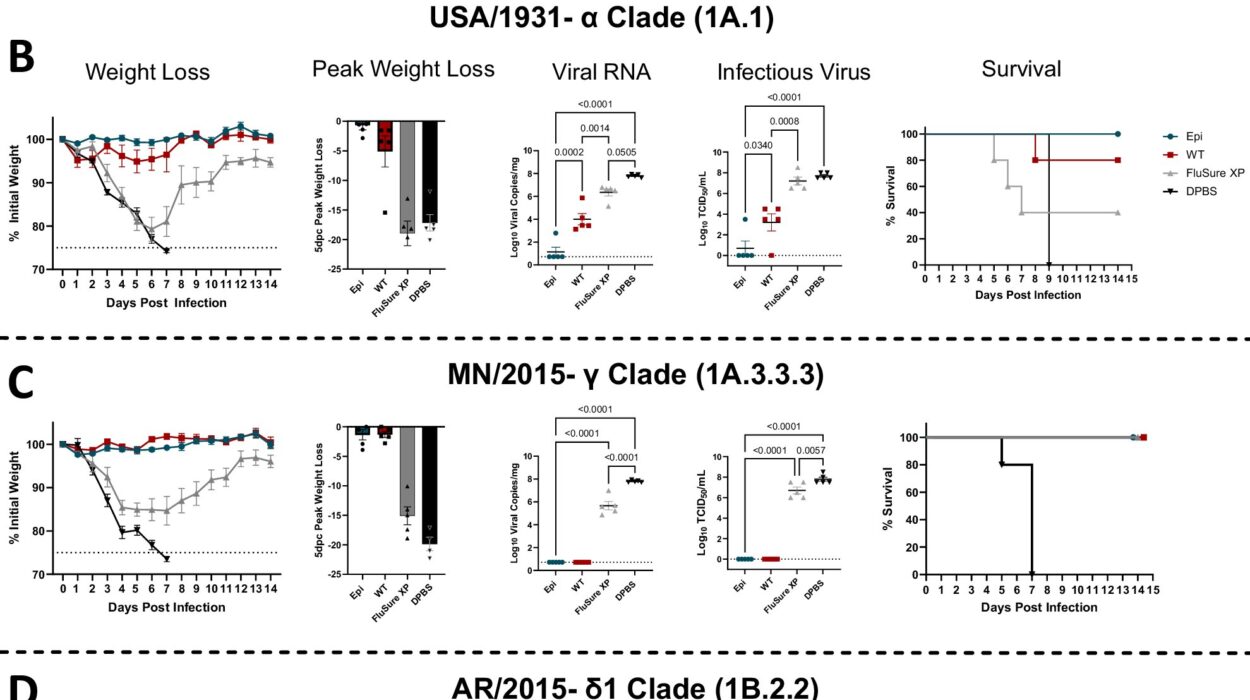It starts quietly for many. A lingering headache. A missed word. A mental blank where a memory used to be. Months, even years after recovering from a COVID-19 infection, millions of people still wrestle with what has become known as “long COVID”—a constellation of symptoms ranging from crushing fatigue to the frustrating, haunting haze of “brain fog.” For years, these symptoms have puzzled clinicians and tormented patients. But now, a new study may finally provide a tangible explanation—rooted not in psychology, but in measurable biological changes inside the brain.
In what is being heralded as a scientific breakthrough, researchers from Corewell Health in Grand Rapids, Michigan, have published the first controlled study that directly compares inflammation and brain stress responses in patients with long COVID against those who have fully recovered. The results are as revealing as they are validating: the brains of long COVID sufferers are physically different. They exhibit signs of inflammation, biochemical imbalances, and a diminished capacity to adapt to stress—all of which may be key to understanding their cognitive difficulties.
This new research, published in the journal PLOS One, is small but mighty. It offers the first biological evidence from real human patients—not animal models—that supports what millions have been saying for years: the fog is real, and it is rooted in the brain.
Decoding Long COVID: A Global Health Puzzle
Long COVID, also called post-acute sequelae of SARS-CoV-2 infection (PASC), is more than just a prolonged recovery. It’s a complex syndrome with symptoms that often appear weeks or months after the initial infection has subsided. These symptoms can range from respiratory problems and chest pain to joint aches and digestive issues. But perhaps the most troubling—and least understood—are the neurological complaints.
Cognitive dysfunction, memory lapses, difficulty concentrating, and mood swings are commonly reported. Yet until now, physicians have lacked the tools to validate these complaints biologically. The standard neuropsychological assessments—the very ones used to evaluate strokes, brain injuries, and dementia—have typically returned normal results in long COVID patients.
This has led to a heartbreaking pattern: patients struggling to articulate what feels like a fundamental shift in brain function, only to be told by doctors and loved ones that everything looks fine. For many, that disconnect breeds frustration, alienation, and even depression.
Enter the new study.
The Corewell Study: Comparing the Quiet Battle Inside the Brain
Led by Dr. Michael Lawrence, a neuropsychologist at Corewell Health, the pilot study analyzed 17 confirmed COVID-positive individuals. Ten were suffering from persistent long COVID symptoms—especially cognitive ones—while seven had fully recovered with no lingering issues. Rather than relying solely on self-reporting or surface-level tests, the researchers dove deeper, assessing not just neurocognitive performance, but also emotional functioning, quality of life, and crucially, blood-based biomarkers that reflect inflammation and stress responses in the brain.
The study’s revelations were sobering.
Long COVID participants had significantly lower levels of nerve growth factor (NGF) in their blood. NGF is a key player in neuroplasticity—the brain’s remarkable ability to adapt, form new connections, and recover from injury. In healthy individuals, NGF helps maintain the health of neurons and promotes regeneration. Lower levels suggest the brain’s capacity to rewire itself is compromised in long COVID patients.
But that wasn’t all.
The researchers also found that these patients had elevated levels of interleukin-10 (IL-10), a cytokine typically associated with anti-inflammatory signaling. While IL-10 is generally a marker of the body trying to cool down inflammation, its persistent elevation may indicate an ongoing tug-of-war between inflammation and the body’s efforts to regulate it—particularly in the central nervous system.
When Tests Look Normal but the Brain Doesn’t Feel Right
Perhaps the most striking finding was the mismatch between standard cognitive test results and the lived experiences of long COVID sufferers. On many conventional neuropsychological assessments, participants in both groups performed similarly. But when tested on letter fluency—a task requiring rapid word generation based on specific letters—long COVID patients stumbled. Their brains, it seemed, had trouble accessing the language centers quickly and fluidly.
This mirrors what many patients have described anecdotally: a mental sluggishness, an inability to “find the right word,” or a disconcerting delay in thought-to-speech translation.
Furthermore, long COVID participants rated themselves significantly lower on quality of life, emotional well-being, physical health, and psychological functioning compared to their fully recovered counterparts. These subjective measures matter, says Dr. Lawrence, because they highlight the real-world impact of the disorder—how it feels to live with a brain that’s no longer running at full speed.
“Although this is a small study and more work needs to be done, from a clinical application standpoint, physicians can potentially identify individuals who are struggling sooner and provide wrap-around care that could be helpful to them,” said Dr. Judith Arnetz, professor emerita at Michigan State University and corresponding author of the study.
A Biological Validation for Millions
For the medical community, this study represents a turning point. Until now, long COVID has remained in the diagnostic shadows—difficult to identify, harder still to treat. Many physicians have struggled to explain why some patients recover completely while others remain mired in a fog for years.
What this study offers is biological evidence—measurable differences in brain chemistry and stress response that distinguish long COVID patients from healthy individuals.
Dr. Lawrence points out that this biological validation could also have psychological benefits. “These patients experience significant frustration, and their symptoms may often be minimized by friends, family and even the medical community,” he said. “It’s tough when everything looks normal on paper, but our patients continue to struggle and report a multitude of difficulties.”
Toward a New Model of Care
This research is more than an academic exercise—it has immediate implications for how we treat long COVID. The authors suggest that physicians should begin evaluating patients more holistically, taking into account inflammatory biomarkers and stress-response measures alongside cognitive assessments.
“We might want to consider a multidisciplinary approach,” said Dr. Arnetz, “including speech therapy, psychotherapy for stress reduction, and medications that target fatigue and cognitive impairment.”
That’s not just theory—it’s a call to action.
By identifying the biological underpinnings of long COVID symptoms, clinicians can move away from dismissive attitudes and toward proactive treatment plans that validate patient experiences and offer real support.
The Unseen Toll: Brain Stress in the Wake of a Pandemic
The findings of this study come at a critical time. Five years after the pandemic began, an estimated tens of millions around the world are still dealing with the lingering effects of the virus. Many can no longer work full-time, participate in family life, or even carry on conversations with the ease they once did. For them, long COVID is not just a medical condition—it is an existential shift.
As public health attention shifts to other crises, there is a growing fear that long COVID sufferers will be forgotten. This study helps ensure that doesn’t happen. It reaffirms that their pain is not imagined. Their struggles are not exaggerations. The brain changes are real, measurable, and deserving of care.
What Comes Next?
This study is just a beginning—a pilot project with only 17 participants. But it opens the door to much larger investigations that can fine-tune our understanding of long COVID’s neurological impacts. Future research will need to explore a wider range of biomarkers, include more diverse populations, and track symptoms over time.
One intriguing question is whether long COVID shares pathways with other post-viral syndromes such as chronic fatigue syndrome or fibromyalgia, both of which also feature cognitive impairments and immune dysregulation. If shared mechanisms exist, treatments developed for long COVID could potentially help millions with other poorly understood illnesses.
For now, the Corewell study offers a rare combination of scientific rigor and human compassion. It does what science does best: it shines a light in the dark and shows us a way forward.
Final Thoughts: Making the Invisible Visible
When COVID-19 emerged, it tore through the world with terrifying speed. The virus devastated lungs, shut down economies, and redefined normal life. But its most insidious effects may be those that linger quietly in the mind—invisible, intangible, but devastating nonetheless.
Thanks to research like this, those effects are no longer shrouded in mystery. The fog is beginning to lift.
For those still struggling, this is more than a study. It is a message: You are not alone. What you are experiencing is real. And science is finally catching up to you.
Reference: Self-reported health, neuropsychological tests and biomarkers in fully recovered COVID-19 patients vs patients with post-COVID cognitive symptoms: a pilot study, PLOS One (2025). On medRxiv: DOI: 10.1101/2024.11.28.24318139






